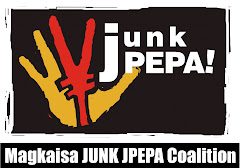This op-ed piece originally came out in the Yellow Pad column of BusinessWorld dated June 4, 2007.
Can JPEPA deliver on its promises?
By Tanya Lat
After her state visit to Japan on May 23-25 2007, Mrs. Gloria Arroyo called on the Senate to ratify the Japan-Philippines Economic Partnership Agreement (JPEPA), which the executive branch submitted to the Senate for ratification in November 2006.
The JPEPA is a combined bilateral investment treaty and free trade agreement, which covers a wide range of issues, including trade in goods (both industrial and agricultural), trade in services, investment, intellectual property, customs procedures, government procurement, cooperation (official development assistance), and dispute settlement.
It is the first in a long line of bilateral agreements that the Philippine government is negotiating. It may also affect the Philippines' commitments under the World Trade Organization (WTO), as well as those under other international treaties that pertain to the environment and human rights, among others.
The government has been trying to convince the public that the accord will be good for the Philippines. The "dynamic gains" under it will reportedly "flow to all sectors of our society, greatly contributing to the country's efforts at alleviating poverty." (See Department of Trade and Industry's briefing paper on JPEPA.)
Can the JPEPA really deliver the projected benefits being bandied about by its proponents? Here are some of the serious issues that the JPEPA raises:
Asymmetrical tariff elimination: The JPEPA will eliminate tariffs on practically all Japanese products entering the Philippines, except for rice and salt (JPEPA Annex 1). On the other hand, Japan was able to exclude 238 tariff lines, which include tomato paste and puree, leguminous vegetables, cigarettes and smoking tobacco, and a wide range of fish and marine products, sugar and related products, and footwear. Why were our negotiators not able to do what Japan did? Was it necessary for us to give up so much?
Market access barriers to Philippine goods: The JPEPA will reportedly facilitate entry of key Philippine exports into the Japanese market. But do Japanese tariffs really reflect this? Bluefin and skipjack tuna, cod, mackerel, and seaweed, for example—items that we produce and can potentially export to Japan—are specifically excluded from the JPEPA. Bananas, which are our top agricultural export to Japan, will have tariffs eliminated only after 10 years. Japan has also refused to lift quantitative restrictions on Philippine pineapples.
Moreover, the very complex rules of origin (ROOs) will undermine any projected benefits that exporters expect to reap under the JPEPA (Chapter 3, JPEPA basic agreement). The JPEPA ROOs—which define what goods are to be considered as made in Japan or in the Philippines so as to be entitled to preferential tariff treatment—consist of not just one but three methodologies, all with their own unique complexities and rules: change in tariff classification, value-added, and process of manufacture. These complex rules of origin may increase compliance costs for exporters and even possibly require them to adjust their production patterns and processes just so they can avail themselves of preferential tariff treatment.
Unreasonable standards for Philippine nurses and caregivers: One of the reported primary benefits of the Philippines under the JPEPA is that the treaty will reportedly enable Philippine health care professionals to work in Japan. But the JPEPA provides that Philippine nurses must master written and spoken Nippongo and pass the nursing board exam (which is in Nippongo) within two years if they are to continue working in Japan as full-fledged nurses. Philippine caregivers are imposed similar requirements. While spoken Nippongo can be learned easily, written Nippongo is a different matter altogether. Mastering the three Japanese alphabets (hiragana, katakana, and kanji) within two years—on top of hospital training—will be very difficult, if not downright impossible.
And even assuming that our nurses and caregivers hurdle this formidable barrier, will they be given decent work? Will they be treated as equals or discriminated against? What safeguards are in place to ensure that they will be protected against exploitation and abuse? The JPEPA is disturbingly silent on this.
Policy inflexibility on investment liberalization: The JPEPA eliminates performance requirements on Japanese investors (Art. 93, JPEPA basic agreement), ostensibly to bring in more Japanese investments. This means that the Philippine government cannot require Japanese investors to transfer technology, employ a certain number of Filipino nationals, or achieve a given level of research and development. This is tantamount to removing policy space for the government to influence foreign direct investment toward achieving specific national development goals.
But will JPEPA really bring in the investors? In a survey conducted just a few months ago, Japanese investors identified the Philippines as the 2nd least-favored investment destination in Asia, citing macroeconomic instability, corruption, contracting and regulatory uncertainty, poor infrastructure, high power costs, high costs of doing business, and peace and order concerns as their reasons for choosing to stay away from the Philippines. Investment liberalization under the JPEPA cannot possibly solve the problem of investment confidence for as long as the government fails to address the root causes of the country's poor investment climate.
Toxic waste trade: The Philippine and Japanese governments have denied that the JPEPA will allow Japan to make the Philippines the dumping ground for its trash. However, by exchanging diplomatic notes on this issue, the two governments have effectively admitted that the concerns raised by environmentalists and civil society on this point are indeed valid. While the Philippine government has yet to release the full text of the diplomatic notes, judging from the press releases, it is doubtful that this "side agreement" will put this issue to rest, as it was not signed by the heads of State.
Even assuming for the sake of argument that such a side agreement would be sufficient to bar the entry of toxic waste, the JPEPA would still allow other kinds of waste to enter the country duty-free. Given our national average waste generation rate of 8.4 million tons per year and the fact that there is no integrated treatment facility for hazardous wastes in the country, can we afford to accept Japan's waste when we have enough trouble disposing of our own waste?
Economic growth and poverty alleviation: The government claims that the JPEPA will spur economic growth and alleviate poverty. However, according to the Philippine Institute of Development Studies (see J. Yap, E. Medalla & F. Aldaba, Assessing the Japan Philippines Economic Partnership Agreement, November 2006), the JPEPA's impact on GDP growth will be a negligible 0.09%. With respect to poverty alleviation, the paper states that it will occur "in Metro Manila where most of the industries are located." But Metro Manila is hardly the place in the Philippines where the poorest of the poor are found. Such minuscule gains should be weighed against the economic and social dislocations, the enviromental damage and the other transaction costs arising from JPEPA.
As pointed out by UP School of Economics Dean Raul Fabella during a forum last March 2007, any comparative advantage we have vis-a-vis Japan will come to pass, with or without a JPEPA. Clearly then, we need this bad deal as much as we need a hole in the head.
Given all of this, it is unlikely that JPEPA will be the engine of economic growth and poverty alleviation that it is being made out to be. In the absence of a national development and industrial plan for the Philippines, JPEPA may very well be a catalyst—not for investment and trade, but for the demise of the Philippine manufacturing and agricultural sectors.
Subscribe to:
Post Comments (Atom)






No comments:
Post a Comment